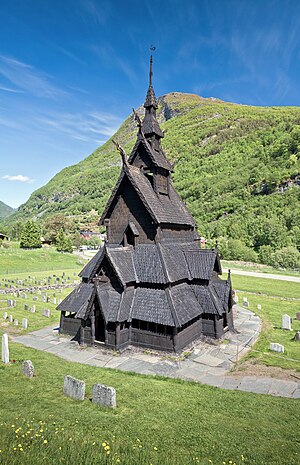Borgund stave church
| Borgund Stave Church Borgund stavkyrkje |
|
|---|---|
 |
|
| Basic information | |
| Location | Borgund, Lærdal, Norway |
| Geographic coordinates | 61°02′50″N 7°48′44″E / 61.04724°N 7.81224°ECoordinates: 61°02′50″N 7°48′44″E / 61.04724°N 7.81224°E |
| Affiliation | Church of Norway |
| Status | Museum |
| Website | Website of Borgund Stave Church |
| Architectural description | |
| Architect(s) | unknown |
| Architectural style | Stave church |
| Completed | 12th century |
Borgund Stave Church (Norwegian: Borgund stavkyrkje) is a stave church located in the village of Borgund in the municipality of Lærdal in Sogn og Fjordane county, Norway. It is classified as a triple nave stave church of the so-called Sogn-type. This is also the best preserved of Norway's 28 extant stave churches. The church is part of the Borgund parish in the Indre Sogn deanery in the Diocese of Bjørgvin, although it is no longer used regularly for church functions, it is now used as a museum and it is run by the Society for the Preservation of Ancient Norwegian Monuments.
Borgund Stave Church was built sometime between 1180 and 1250 AD with later additions and restorations. Its walls are formed by vertical wooden boards, or staves, hence the name "stave church". The four corner posts were connected to one another by ground sills, resting on a stone foundation. The rest of the staves then rise from the ground sills, each stave notched and grooved along the sides so that they lock into one another, forming a sturdy wall.
Borgund is built on a basilica plan, with reduced side aisles, with an added chancel and apse. It has a raised central nave demarcated on four sides by an arcade. An ambulatory runs around this platform and into the chancel and apse, both added in the 14th century. An additional ambulatory, in the form of a porch, runs around the exterior of the building, sheltered under the overhanging shingled roof. The floor plan of this church resembles that of a central plan, double-shelled Greek cross with an apse attached to one end in place of the fourth arm. The entries to the church are in the three arms of the almost-cross.
...
Wikipedia
